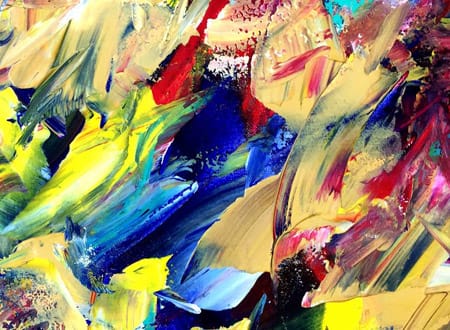The concept behind the word Abstraction literally means to separate or be separate from something else. Hence, when we talk ‘abstraction in art,’ we are talking about an image or an idea removed from a literal interpretation. The thing in question is somehow made obtuse or rearranged in a manner that it bears little resemblance to reality.
Abstraction isn’t a style of art nor an art movement but exists in all art form to some level. One could also include photography as well, as fine art photographers sometimes use abstraction as well.
A dictionary definition of ‘Abstraction’ suggests ‘freedom from representational qualities in art’ and so ‘not representing things pictorially’. Moreover, The Tate Museum describes the term, ‘Abstraction’, as when the artist has ‘removed (abstracted) elements from an object to create a more simplified form’ or create something which ‘has no source at all in external reality’.
‘Abstraction in art’ can take gestural marks or more commonly geometric shapes or forms that possess symbolism, which have little to no relationship to an external visual reality.
The idea of ‘pure’ abstraction is completely remote to reality and is not a depiction of it, but rather an entity unto itself. To me as an artist, ‘pure’ abstraction seems more prevalent in abstract expressionism. The art here constructed does not reflect reality, but one’s emotions and so emotions could be considered an abstraction.
Abstraction in art, by some, is a moral dimension. Such abstractions represent virtues, purity, spirituality and minimalism.
My work uses ‘Pure Abstraction,’ in its essence, in that the painting resembles nothing pictorially in reality. But! This is a powerful way to access the subconscious and emotions of the viewer. I guess my first real influence, was Leonardo da Vinci, which is ironic as he was literally a realistic painter. Someone who painted in a way to directly resemble reality. However, in 1981 I turned to Jackson Pollack and the New York art school of painting. This transition was so far removed from da Vinci’s work, that I had traversed from one side of art to the other; the abstraction side.
Also see my short article on Hypnogogic Abstraction.
You may also like to read the article about me on the Art Blog about Physics and Art.
Abstraction in art is a powerful and transformative concept that has shaped the trajectory of art history, radically altering our perceptions of what art can be and how it communicates with audiences. Rising to prominence in the early 20th century, abstraction represented a departure from traditional artistic conventions, eschewing representational imagery for a language of form, color, and line that exists independently of the observable world.
At its core, abstraction is the process of distilling the essence of a subject, removing it from its literal context, and expressing it in a simplified or even unrecognizable form. In abstract art, concrete depictions of people, objects, and landscapes are replaced by visual elements such as shapes, lines, and colors, which are often arranged in non-objective or non-representational compositions.
Artists such as Wassily Kandinsky, Piet Mondrian, and Kazimir Malevich were among the pioneers of this transformative movement. Each embraced abstraction in their own unique way, exploring its potential to communicate complex ideas and emotions beyond the confines of representational art. For example, Kandinsky, often credited with painting the first purely abstract works, sought to evoke sound and emotion through his dynamic compositions, drawing parallels between painting and music.
A key characteristic of abstraction in art is its emphasis on the inherent properties of the medium. Rather than using paint, canvas, or sculptural materials to mimic the textures and forms of the natural world, abstract artists celebrate these materials for their own qualities and potential. This can be seen in the thick impasto of Willem de Kooning’s action paintings, where the visceral quality of the paint itself becomes a vital part of the work’s expressive power.
The appeal and power of abstraction lie in its capacity to evoke a direct, visceral response from the viewer. Without representational forms to guide interpretation, viewers are free to respond to the work’s pure visual elements, leading to a more subjective and personal experience. Rothko’s Color Field paintings, with their vast expanses of luminous color, aim to elicit such an emotional response, suggesting that art can provoke feelings and introspection without resorting to recognizable imagery.
Moreover, abstraction provides artists with a platform to explore broader conceptual and philosophical ideas. For instance, Mondrian’s geometric compositions reflect his belief in a universal harmony underlying the chaos of reality, while Malevich’s austere, minimalistic works express his vision of a non-objective world, free from material concerns.
In conclusion, abstraction in art signifies a momentous shift in artistic creativity and interpretation. By severing ties with the representational, abstraction has given artists the freedom to explore the expressive potential of form, color, and line in their own right, and to engage viewers in a more immediate and personal dialogue. While diverse in its manifestations, the power of abstraction lies in its ability to evoke emotion, provoke thought, and challenge our perceptions of art and reality.


